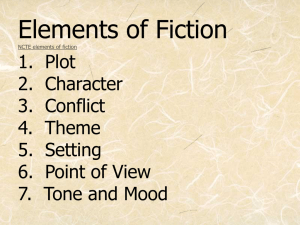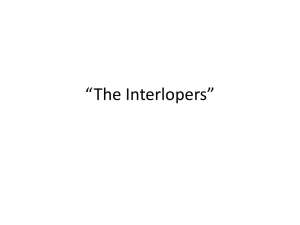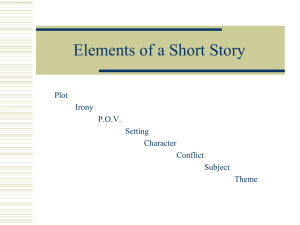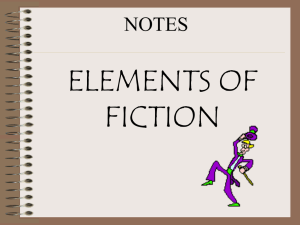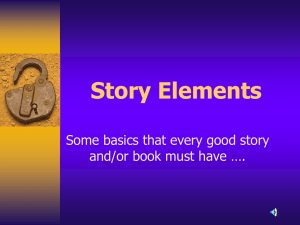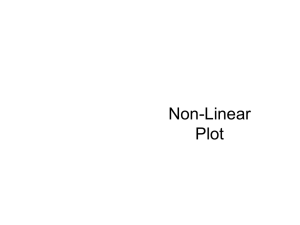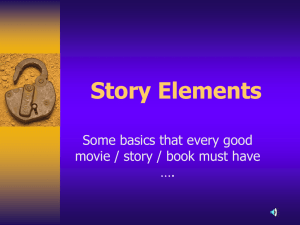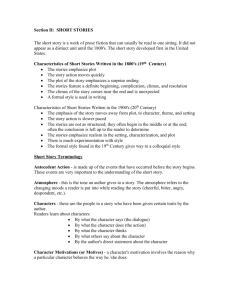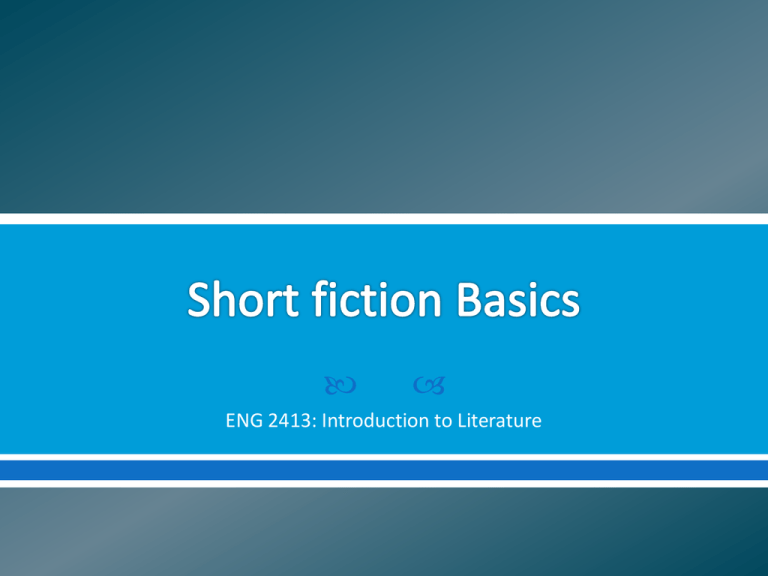
ENG 2413: Introduction to Literature
Short stories, novellas, and novels are usually written in prose, not poetry
(though both prose and poetry are fiction).
Short stories, novellas, and novels all share similar traits and use the same
techniques and literary conventions. The main differences in the three types of
fiction are mainly in length.
A short story is usually 16,000-20,000 words long.
A novella is 15,000-50,000 words long.
A novel is at least 40,000 words long.
These are ballpark numbers, though, and some popular fiction novels may be
30,000 words long.
Though this class only reads short fiction, the same techniques we use to
analyze and understand short stories and novellas also apply to novels.
The central elements to prose fiction include: plot, point of view, character,
setting, symbol, and theme.
Prose fiction often uses metaphor, simile, allegory, and other more poetic
conventions. These are included under the general label of “symbol.”
The plot of a typical realistic short story follows the typical plot
line. The action is usually composed of a sequence of causally
related actions or events that are not necessarily presented in
chronological order. Flashbacks may disrupt the linear movement
of the plot.
The main character in the story is called the protagonist. This
comes from the word “agon” meaning actor and “proto” meaning
first. Though a hero is always a protagonist, a protagonist is not
always a hero (for example, a story with the villain as the main
character). The antagonist is the character that represents the
main force opposed to the protagonist, but this is not always a
villain. Sometimes an antagonist might be trying to help the
protagonist.
A plot must include conflict. A basic definition of conflict is that
which stands in the way of the protagonist getting what he/she
desires and the struggle that character makes to overcome that
conflict. There may be more than one in a story, and most longer
stories have several minor conflicts.
Internal conflicts – also called man vs. man. The struggle comes
from inside the protagonist.
External conflicts – The struggle comes from outside of the
protagonist. There are many types of external conflicts: man vs.
society; man vs. god/fate/supernatural; man vs. nature; man vs.
technology.
Man vs. Society: a character goes up against the government, an
organization (insurance company), his community.
Man vs. God/Fate/Supernatural: a character goes up against
spiritual forces like Jonah fleeing from God in the Bible, or a
character trying to oppose his fate.
Man vs. Nature: a character has to fight the world – a tornado,
earthquake, crossing a large river, a giant Great White shark.
Sometimes these stories depict nature as evil – out to get people.
Sometimes nature is neutral – it simply does what it does. There is
no malevolence involved.
Man vs. Technology: a character has to fight a machine or
something not natural – a cyborg assassin from the future, a
computer program that will destroy the entire world’s economic
system, a demon-possessed car.
Foreshadowing - the "clues" provided by the author to alert the reader of
impending action.
Exposition - essential information is provided to the reader. In drama,
much of the expository information is given in the stage directions. Step
1 in Freytag’s Pyramid.
Rising Action – Beginning with the inciting incident (what sets off the
conflict), tension starts to rise and conflict between characters becomes
evident. Step 2 in Freytag’s Pyramid.
Climax - the tension reaches its peak and the main character, usually, is
faced with a decision on which the plot turns. Often, the main character
has an epiphany (insight). Step 3 in Freytag’s Pyramid.
Falling Action - the consequences of the decision made in the climax
begin to unfold. At the end of the falling action but before the conclusion
usually comes the resolution Step 4 in Freytag’s Pyramid.
Conclusion - the "tying up of loose ends," the ultimate resolution of the
conflict. This often signals a return to a more stable, normal situation.
Step 5 in Freytag’s Pyramid.
Flat - characters who do not change
Round - changing characters
Stock - characters who look familiar to us (i.e. the jock with the
football uniform, carrying a ball, the sleuth with the long trench
coat standing on the dimly lit street corner)
Main - characters who make the major decisions and who are
usually faced with difficult decisions or conflicts; these characters
are almost always round
Supporting - characters whose roles are dependent on the main
character(s) and exist to support them in some way; these
characters are almost always flat
Narrative Summary without judgment
Narrative Description with implied or explicit judgment
Surface details of dress & physical appearance
Characters' actions - what they do
Characters' speech - what they say
Characters' consciousness - what they think and feel
Who is telling the story? There are a few options as follows:
o External vs. Internal – The narrator is not part of the story (external) or is part of the story
(internal). If a narrator is part of the story, the reader should question his/her
reliability/objectivity.
o Reliable vs. unreliable – The reader can either trust the narrator’s telling of events or
discussion of character (reliable), or the reader cannot trust that the narrator is being
objective and impartial when telling about what’s happening (unreliable).
o Omniscient vs. Limited – A limited narrator sees events and people in the story through
the perspective of one or two characters only. This limits when, where, and what the
narrator sees happening. An omniscient narrator, often called the God point of view, sees
all things.
o First Person vs. Third Person - the narrator speaks from one persons point of view (I, me,
we) at a time, and often in one story the narrator stays only in that character’s POV. In
Third Person POV (he, she, they, it), the narrator sees action outside of any one characters
perspective and tells the reader what is happening from a distance. An omniscient 3rd
person narrator can see into the heads of characters and can tell the reader what that
character is thinking/feeling. A limited 3rd person narrator can only share what is actually
happening via dialogue and action.
Note: Whether a writer uses first or third person, he or she must also decide how
much to let the narrator know about the characters. Omniscient narrators enter
the minds of each character, and limited omniscient narrators have limited
knowledge of only one or two characters.
Setting- the place or location of a story's action, along with the
time it occurred.
Theme - The story's main idea or point, its implied view of life and
conduct. The theme grows out of the relationship of the other
elements.
Irony - Irony always involves a contrast or discrepancy between one
thing and another. There are different types of irony:
o Verbal irony - we say the opposite of what we mean
o Irony of circumstance/situational irony - discrepancies between what seems
to be and what is ( also refers to occasions where individuals expect one
thing to occur only to discover that the opposite happens)
o Dramatic irony - the discrepancy between what the characters know and
what the reader knows.
Symbol - Objects, actions, or events that convey meaning. Specific
techniques include metaphor, simile, and allegory.
The following questions can be used to help readers break down a story. They can also provide content for
feedback journals and essay questions. Not all questions will be relevant for all stories.
1.
Explain the title. In what way is it suitable to the story?
2.
What is the predominant element in the story - plot, theme, character, setting?
3.
Who is the single main character about whom the story centers?
4.
What sort of conflict confronts the leading character or characters?
5.
How is the conflict resolved?
6.
How does the author handle characterization? By description? Conversation of the characters? Actions of
the characters? Combination of these methods?
7.
Who tells the story? What point of view is used? 1st person? Omniscient? Limited? Third Person?
8.
Where does the primary action take place?
9.
What is the time setting for the action? Period of history? Season? Time of day?
10.
How much time does the story cover? A few minutes? A lifetime? How long?
11.
How does the story get started? What is the initial incident?
12.
Briefly describe the rising action of the story.
13.
What is the high point, or climax, of the story?
14.
Discuss the falling action or close of the story
15.
Does this story create any special mood?
16.
Is this story realistic or true to life? Explain your answers by giving examples.
17.
Are the events or incidents of the plot presented in flashback or in chronological order?
18.
What is the general theme of the story? What is the underlying theme? Can you name any other stories
with a similar theme?
19.
Did you identify with any of the characters?
20.
Does this story contain any of the following elements: symbolism; incongruity; suspense; surprise ending;
irony; satire?
21.
Was there a villain in the story? a hero? a dynamic character? Etc.
22.
Can you find any examples of figurative language? Simile? Metaphor? Personification?
23.
Does the story contain a single effect or impression for the reader? If so, what?
24.
Name one major personality trait of each leading character, and tell how the author makes the reader
conscious of this trait.
25.
Does the story have a moral? If not, what do you think the purpose of the author was?
This resource sheet was found free at www.englishresources.co.uk
© 1999, English Resources, all rights reserved


